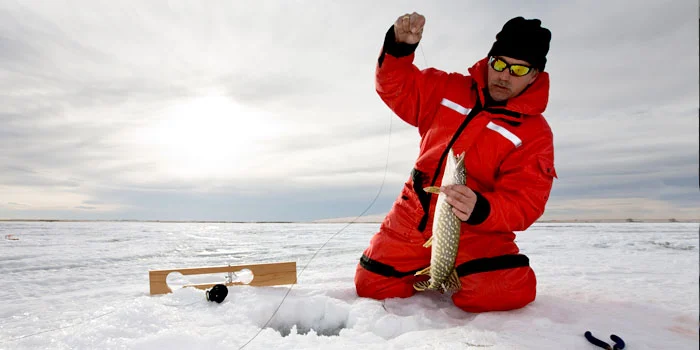How to Stay Safe While Ice Fishing


Anglers don’t have to give up their favorite passion when the season changes. Winter provides a unique opportunity for ice fishing in many of the cooler climates in the United States. But while ice fishing can be fun, it isn’t without risk. First, how do you know if the ice is thick enough for fishing? And once you drop your line, what other ice fishing safety tips do you need to know to avoid falling head-high into bone-chilling water?
Keep the fun in your winter fishing adventures by following these five tips to stay safe while ice fishing (and check out these podcasts featuring pro tips from anglers passionate about ice fishing).
Before you head out, pack the necessary equipment to make your trip safe and enjoyable. Wear appropriate footwear such as crampons (or creepers) that fit on the bottom of your shoes to give you traction on the ice. Be sure your clothes keep your head, hands and feet warm and dry to prevent hypothermia and frostbite. Also, consider taking ice picks, rescue claws, a 50-foot rope, a first-aid kit, an extra set of dry clothes and a life jacket — all of which are essential elements of your ice fishing safety kit.
Make sure there are at least 4 inches of clear, solid surface ice before you venture out onto a lake or river. Thinner ice may support one person, but ice thickness can vary from spot to spot on lakes and rivers. Any depth less than 3 inches of ice is not safe to walk on. Snowmobiles and ATVs need 5 inches, and cars and light trucks need at least 8 to 12 inches. Best bet, drive and park on land then walk out (or ride snowmobiles) to set up your fishing spot. You will know the ice is safe for fishing if it is clear, blue and at least 4 inches thick. Keep in mind, drilling multiple holes in one area will make the ice surface less stable, so be sure to spread out when you are with a group.
Thick ice requires an auger or power drill to make a fishing hole. Make sure you have stable footing before you start drilling. If your fishing area has slick spots and snowy spots, drill while standing on a snowy spot to get better grip. If slick surfaces are your only option, pack a pair of cleats, ice grips and knee pads to stay in place while drilling. And while you’re drilling, do not push down. Let the auger do the work to avoid slipping when the blade breaks through the ice.
Plan ahead to get all of your gear and equipment back to land before darkness settles in. Navigating by flashlight or snowmobile headlight does not put the entire area in clear view. Don’t be rushed getting off the ice, or your chances of making a mistake will increase. And do not ride out a storm on the ice if dark clouds threaten to cut your fishing excursion short. If the weather turns rough, pack it up to stay safe. Always have a phone with GPS in case the conditions outside make you disoriented.
Don’t fish alone — be sure to bring a friend who can call for help or attempt a rescue if you fall in. Also, let your family know where you’re fishing and when you plan to be home.
Are you protected from the unexpected? Contact your Farm Bureau agent today to make sure you're covered.